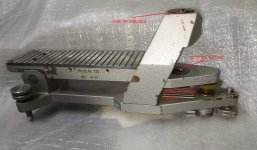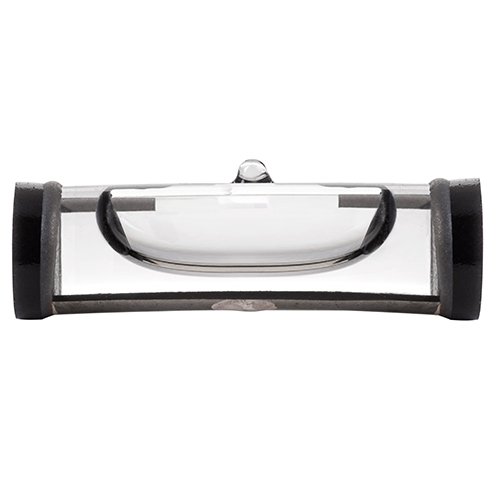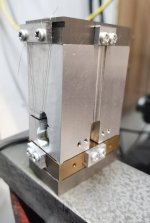rhb --
Today's version of the Leica Geosystems "Nivel" tiltmeter, which is based on the two-fluid "compensator" developed for the Kern DKM-2A theodolite, can be seen here:
https://leica-geosystems.com/en-us/...stems/geotechnical-sensors/leica-nivel210_220 To the best of my knowledge, the Nivel has never been sold as an "electronic level" per se, but if it's not an electronic level it's the electronic level's kissingest cousin.
As I mentioned, Kern developed the two-fluid level for their DKM-2 second-order theodolite in the 1960s. In that use, it eliminated the need for a so-called "collimator level" that had long been used to compensate for residual errors in setting a theodolite's vertical (aka azimuth) axis vertical before making vertical-angle measurements. Automatic compensation proved to be both much more rapid than making manual adjustments with the collimator level screw, and proved to eliminate a fair number of human errors in making those manual adjustments.
Kern's new automatic-compensation theodolite, the DKM-2A (A signifying Automatic) was very well liked by surveyors doing geodetic work and by those doing industrial work. Kern eventually realized that the two-fluid compensator could also be used to quantify -- and subsequently correct analytically -- instrument plumbing error in the vertical plane perpendicular to the telescope line of sight, thus replacing the "striding level" that had been used historically.
Kern introduced a new variant of their second-order theodolite, the DKM-2AM, featuring a "trunnion-axis micrometer. I doubt that very many of the M-models were sold, I've only seen one in 42 years as an industrial surveyor.
With the advent of the "electronic" theodolite, Kern introduced an electronically-read version of the two-fluid level in their digital theodlites. The first version, the E-1, had only vertical-angle compensation, while the improved version, the E-2, featured automatic compensation of both vertical and horizontal angle measurement errors caused by residual plumbing errors .
In the mid 1980s, my employer bought its first electronic theodolite, a Kern E2EC (E meaning Erect image, C meaning equipped for bright-line autocollimation). At that time, we were using a digital electronic level model that was at the bleeding edge of its time's technology.
We had an urgent job that required a precisely-plumbed rotary table, and the digital electronic levels were flaking out. Our earlier-generation analog electronic levels were at launch base, and we couldn't find anyone locally who had an unused electronic level that we could borrow or rent. So, one of my fellow engineers came up with the idea of mounting an autocollimation mirror on the rotary table we needed to set up, and set up four theodolites on instrument stands so that they could be used to measure the mirror-normal zenith angle directions at the four cardinal rotary table positions.
Having done that, we calculated the average mirror-normal zenith angle, and adjusted the three Unisorb Lev-L-Line wedge jacks that supported the rotary table baseplate to bring the mirror-normal directions to the average position.
That technique worked, but it took several times the manpower and time that using electronic levels.
I wasn't in the hands-on crew, but in reviewing their data and discussing their process, I realized that the the E2EC theodolite could itself act as a digital electronic level.
One of the E2EC functions allowed the error measured by the two-fluid compensator to be displayed, in two perpendicular directions simultaneously. After rough leveling the rotary table surface (with a millwright level such as the Starrett 98) and then mounting and rough leveling the theodolite on the rotary table surface, we could set the theodolite horizontal pointing until the telescope and trunnion axes were orthogonal to the leveling wedge triangle.
From that point, it was a matter of 1) recording the tilt errors shown on the theodolite display, 2) rotating the rotary table 180 degrees and again recording the tilt errors shown on the theodolite display, and 3) calculating the average of the north/south and east/west tilt errors. At that point it became a simple matter of adjusting the leveling wedges until the theodolite display showed actual errors equal to the calculated average errors. Bingo.
Shortly after that, the same technique was modified for use with the single-axis compensator in the Kern DKM-2A theodolite. Then, a decade or so later, we further modified the technique to work with the Zeiss and Leica/Wild theodolites that were available at that time, the Kern instruments having been discontinued.
Ok, you asked.
Incidentally, the Wild-Heerbrugg website is -- or at least was -- a private website, not one operated by Leica Geosystems. As a huge fancier of Kern theodolites, I was very disappointed when Leica discontinued the Kern instruments, BUT Leica has been very good about supplying archived literature about long-discontinued products from their herd of former competitors.





 I hope that I could somehow help.
I hope that I could somehow help.



